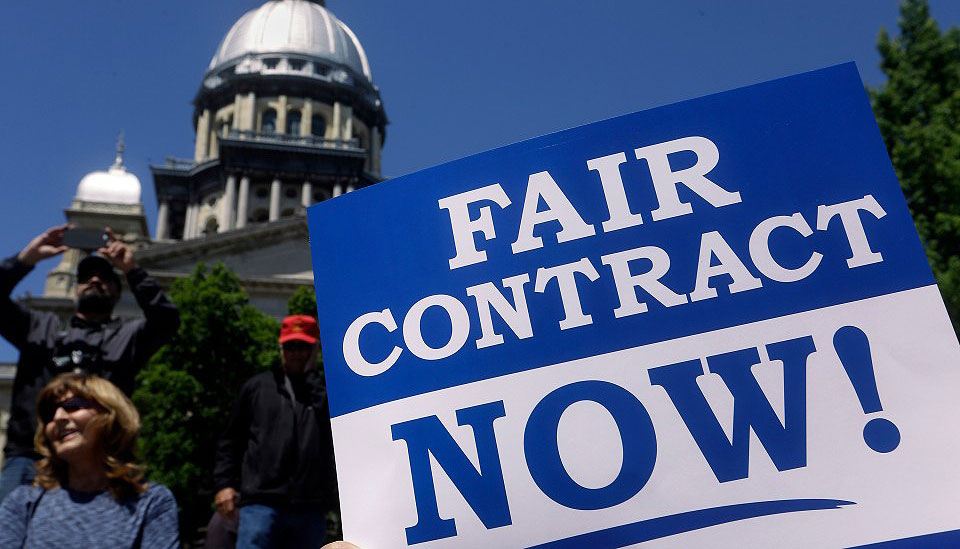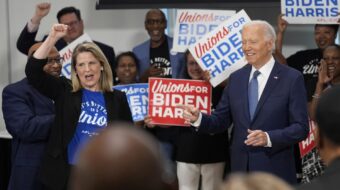
SPRINGFIELD, Ill. (PAI)–Taxes for everyday Illinoisans would not go up if the voters pass the proposed Workers Rights Amendment on November 8. In fact, the financial burden on taxpayers would decline, according to a new study by researchers from the Illinois Economic Policy Institute and the University of Illinois at Urbana-Champaign.
The Illinois constitutional amendment is one of two on state ballots this fall dealing with collective bargaining rights. The other, its exact opposite, would enshrine so-called “right to work” in deep-red Tennessee’s constitution. The state AFL-CIO strongly opposes that.
The Illinois Workers’ Rights Amendment would improve the state’s economy and boost incomes and better working conditions for workers, according to the study, which adds that union workers are less likely to rely on public aid than their non-union counterparts, and they contribute 8% more to state income taxes.
“The data shows the Workers’ Rights Amendment would protect Illinois’ competitive advantage for essential workers,” said Frank Manzo IV, executive director for the Illinois Economic Policy Institute (IEPI) and one of the study’s authors.
“Construction workers, police officers, first responders, teachers, and Registered Nurses all earn between 5% and 35% more in Illinois, and they’re also more likely to have health insurance and to own their homes in Illinois.”
Compared to states without the right to collectively bargain and share the costs of union representation, such as Iowa and Kentucky, Illinois’ workers on average earn 15% higher incomes–more than $7,000 more each per year–and are 5% more likely to have health insurance coverage, research shows.
They also are more likely to own their homes, less likely to live in poverty, and 32% less likely to lose their lives due to preventable accidents on-the-job.
By passing the Workers’ Rights Amendment–preventing future efforts to weaken collective bargaining–voters “can protect an estimated $43 billion in earned income for workers, health insurance coverage for nearly 300,000 workers, and prevent as many as 90 on-the-job fatalities each year,” Manzo said.
Paul Pater, a Registered Nurse with the Illinois Nurses Association, told Chicago public radio the amendment would help both private- and public-sector workers “feel more secure, more safe” in their jobs. He said being part of a union helped him and his colleagues win higher wages and lead to “direct safety initiatives, things like ensuring we have enough respirators at work, enough safety equipment during Covid…to keep our people safe and keep our patients safe.”
The Workers’ Rights Amendment would give power to workers, not corporations, Pater continued.
It “just provides a boon to those workers who are concerned that they’re going to be fired for trying to organize a workplace, for standing up for themselves, for demanding better wages and safer working conditions,” he added.
The Labor Paper also asked random union members and retirees why they back the amendment. Communications Workers Local 3407 member Tyler Kirk linked it to a national issue: The U.S. Supreme Court’s removal of the constitutional right to abortion.
“Right now, in light of the decision on Roe”—the original 1973 High Court ruling legalizing abortion which this court majority destroyed—“I like protecting our rights at the local level,” Kirk said. “Our rights are fundamental.”
In analyzing the Workers’ Rights Amendment’s potential impacts on Illinois, researchers compared economic and workforce outcomes between union and nonunion workers across the state, and between Illinois and the 27 states that have passed state laws to weaken unions.
“Our analysis reveals that unions not only deliver higher wages and better benefits for Illinois workers relative to their nonunion peers but that they are substantially better for public budgets,” Manzo said.
The economic impacts of protecting workers’ rights are not limited to workers. On average, the economies of “free rider” states–where lawmakers prohibit labor agreements requiring workers represented by unions to share in the costs of negotiating and enforcing contracts–grew 3% slower and their annual workforce productivity was 18% lower than states that support collective bargaining rights.
The data also shows that collective bargaining is a good value for taxpayers because higher wages for workers translate to increased tax revenues and less reliance and reduced government spending on social safety-net programs.
Specifically, the study’s analysis of Illinois workers without advanced degrees shows the benefits of union membership for those who vote for representation:
- Payroll taxes (union workers contribute $11,606; non-union workers $10,951).
- Percent below poverty (union 2.5%; non-union 5.9%).
- Percent on Medicaid (union 2.7%; non-union 6.2%).
- Percent on food stamps (union 2.4%; non-union 4.4%).
- Percent needing the Earned Income Tax Credit (EITC) (union 6.7%; non-union 9.1%).
Ultimately, by preventing state politicians from ever enacting laws weakening workers’ rights, researchers predicted the Workers’ Rights Amendment could play an important role in protecting the state’s relatively higher wages, benefits, and safety standards.
Fewer people needing assistance from the state means less of a burden on public funds derived from taxes.
If attack ads and disinformation cause voters to reject the proposed amendment, and Illinois’ labor market becomes like “free-rider” states that don’t support collective bargaining, the statewide consequences would be significant, the study shows:
- Inflation-adjusted annual incomes statewide would fall $43 billion.
- About 281,000 workers would lose health insurance coverage.
- The number of workers who own homes would drop by 134,700.
- More than 70,000 workers would fall below the poverty rate.
- There would be almost 900 more on-the-job fatalities in the next decade.
“At a time when Americans don’t seem to agree on much, public polling has shown historic levels of bipartisan support for unions and the protection of collective bargaining rights,” Manzo said.
Indeed, the state legislature’s overwhelming bipartisan approval of the amendment–80-30 in the House and 49-7 in the Senate–reflects that support. The amendment overcame corporate opposition in Springfield. Since then, supporters have raised $13 million through September 30, Illinois Newsline reports. The foes have not reported third-quarter fundraising, but through June 30, they raised $1 million, all from right-winger Richard Uihlein.
“Our study shows that these opinions are not only well-founded but they are also overwhelmingly supported by real-world economic data,” Manzo said. “Data shows that when states support collective bargaining, the economy does better and job quality is higher.
“Workers earn more, are more likely to have health insurance, and are more likely to own their homes. It’s also better for public budgets, and [for] the economic imperatives of higher growth, fewer labor shortages, more productivity, and better safety outcomes on the job site.”
Press Associates Union News Service contributed the Tennessee and campaign finance data for this story.












Comments